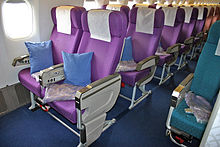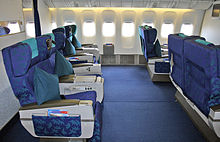Malaysia Airlines Flight 370
Malaysia Airlines Flight 370 (flight numbers MH370 and via codesharing with China Southern Airlines CZ748) was a scheduled international flight from Kuala Lumpur to Beijing in which a Malaysia Airlines Boeing 777 disappeared from air traffic control surveillance at Subang Airport at 01:21 local time on 8 March 2014. Since then, the aircraft has been considered missing.
After the authorities had initially assumed that the aircraft had crashed in the Gulf of Thailand, it became known in the course of the following days that the aircraft had apparently changed course and had continued to send automatic signals to a satellite for up to seven hours after disappearing from civil airspace surveillance. During this process, the satellite link was intermittently lost, but about an hour after the disappearance, the aircraft logged back into the ground station. Air accident investigators believe that communications systems were disabled at the border with Vietnamese airspace and a person on board first steered the plane back toward Malaysia, then along the Thai border and around Penang Island across the Strait of Malacca. The plane then circled Indonesia and continued south over the Indian Ocean, presumably on autopilot, until the flight ended west of Australia. Based on circumstantial evidence, investigators believe it is likely that the aircraft crashed into the ocean after running out of fuel without a pilot; the search area has been narrowed with this assumption. There was great confusion for hours in the air traffic control of the countries involved, and it remains unclear to what extent the Malaysian military, which in any case remained inactive, was informed about the incident.
The final report was released on 30 July 2018. Along with this report, the French authorities' analysis of the flaperon, which was the first piece of debris to be accidentally discovered on July 29, 2015, was also released after years of delay. Analysis of the damage to this flaperon suggests MH370 was not under the control of a pilot at the time of the crash.
Despite the most expensive search operation in the history of aviation, costing almost 150 million euros, the wreckage and the flight recorder have not yet been found. Numerous countries took part in the search, which initially concentrated on the waters bordering Malaysia and, from 17 March 2014, on the southern Indian Ocean. Since then, Australia has coordinated the search for the missing aircraft. By 28 April 2014, 4.5 million km² of sea surface had been searched before the search for drifting debris was suspended due to insufficient chance of success. From 21 May to 5 November 2014, a sea area of 150,000 km² calculated by the satellite and radar data was mapped in preparation for an extensive deep-sea search for the wreck by sonar and underwater vehicles. This deep-sea search began on October 6, 2014, and was terminated without results on January 17, 2017, after 120,000 km² of seabed had been searched. The private company Ocean Infinity signed a contract with the Malaysian government on 10 January 2018 to search for the wreck in the area further north on a pay only if successful (no cure, no fee) basis. This search operation commenced on 21 January 2018 (CET) and was also suspended with an announcement on 29 May 2018 that no evidence of the wreck had been discovered.
Since the main wreckage has not yet been located, Flight MH370 is the only modern jet aircraft still missing today that was carrying passengers at the time of the accident. In addition, while no physical evidence of some commercial aircraft has been found to date, never before has a wide-body jet carrying passengers at the time of the disaster been considered to have disappeared without a trace for so long. It wasn't until July 29, 2015, 508 days after the disappearance, that a first piece of washed-up debris was accidentally found. The historically longest search until then to find the first debris of a passenger jet lasted ten days for Adam Air Flight 574, which crashed in 2007.
For Malaysia Airlines, the incident was the worst disaster to date, before the shooting down of Malaysia Airlines Flight 17 over Ukraine four months later claimed even more lives. So far, no official cause has been given for the disappearance of flight MH370. It is considered one of the greatest mysteries in aviation history.
Airplane
The Boeing 777-200ER aircraft, with aircraft registration 9M-MRO and serial number 28420, was equipped with two Rolls-Royce Trent 892 engines. It could seat 282 passengers (35 in business class, 247 in economy class) and had a range of approximately 12,800 km. The aircraft was delivered on 31 May 2002. It was therefore not particularly old at the time of the incident, being eleven years and nine months old. The left engine was newer than the right, and the engines had different fuel consumption. The registration certificate had to be replaced in 2006.
The aircraft underwent an A-check on 23 February 2014, during which no abnormalities were discovered. The aircraft has completed over 53,400 hours of operation and 7526 flights. However, on August 9, 2012, the aircraft had been involved in an aviation accident when it collided with the tail of another aircraft while taxiing at Shanghai-Pudong Airport, causing the right wing tip to break off.

Economy Class Seats (2004)

Seats in Business Class (2004)
Passengers and crew
| Flight MH370: nationalities of passengers | |
| Nationality | Number |
| China People's Republic of | 152 |
| Malaysia | 50 |
| Indonesia | 7 |
| Australia | 6 |
| India | 5 |
| France | 4 |
| United States | 3 |
| Iran | 2 |
| Canada | 2 |
| New Zealand | 2 |
| Ukraine Ukraine | 2 |
| Hong Kong | 1 |
| Netherlands | 1 |
| Taiwan | 1 |
| Russia | 1 |
| Total (15) | 239 |
| 1 of them 12 crew 3 initially listed under Mainland China, | |
On board were twelve crew members and 227 passengers from 15 nations.
The twelve-member crew was composed exclusively of Malaysians. The 52-year-old flight captain, Zaharie Ahmad Shah, had been working for Malaysia Airlines since 1981 and was very experienced with over 18,000 flying hours. He was an examiner authorised to conduct flight simulator tests for pilots. First Officer Fariq Abdul Hamid, 27, had been with Malaysia Airlines since 2007 and had 2813 flight hours to his credit. This flight was the first flight for the first officer on a Boeing 777 after successfully completing his type retraining, thus the first flight without an additional co-pilot trainer. The captain was the first officer's trainer on this flight.
About two-thirds of the 227 passengers were nationals of the People's Republic of China. Among them were a group of 19 artists returning from an exhibition of their work in Kuala Lumpur and a well-known kung fu stuntman. Thirty-eight passengers were from Malaysia. The passengers also included 20 Chinese and Malaysian employees of Freescale Semiconductor.
The passengers also included two young Iranians who were travelling with stolen passports. They claimed the identity of an Austrian and an Italian, whose passports had previously been stolen in Thailand. The two people had connecting flights from Beijing to Amsterdam and from there onward flights to Frankfurt am Main and Copenhagen respectively. Also because the flights of the two had been booked in a Thai travel agency by a third party and paid for in cash, a terrorist background was initially considered. However, only a few days after the disappearance of the plane, the international police organization Interpol announced that it was apparently only a matter of illegal immigrants. Interpol expressed incomprehension that the two passengers were able to board the plane even though the passport thefts were recorded in the Stolen and Lost Travel Documents Database.
There were conflicting statements about whether other people with false passports were on board. The director of the Civil Aviation Authority said on 10 March that there were concerns about five passengers who had not flown. The Malaysian police chief, on the other hand, said the following day that all the passengers who had booked the flight had also flown and that they were looking into the possibility that a syndicate had provided the two stolen passports. A Chinese national whose passport number matched that of a passenger with a different name on the passenger list never boarded the plane, Chinese police said.
In late May 2016, it was first revealed that numerous Malaysian officials at the airport in Kuala Lumpur, possibly linked to a people smuggling syndicate, had repeatedly sabotaged the electronic passport verification system. The computers had also been hacked from the outside, it could be seen from cursors moving by themselves. These manipulations and system crashes, where passports were only stamped manually, had been going on since 2010. It was not until July 2014, in response to the security failures at MH370, that an electronic system was introduced to compare passport numbers with Interpol.
Search within the encyclopedia